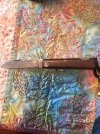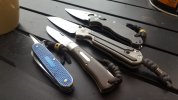Speaking from the point of view of someone who lives outside the US.
I have seen time after time people saying "oh I had a little problem with my GEC. No big deal I will just send it back." I am guess there is some sort of flat rate envelope that makes this cheap and fast.
From outside America's borders, I might pay 30 dollars to get a package shipped that will arrive maybe in a couple of weeks. Or more. Possibly get snagged at customs going either direction. And I don't even have to cross any oceans.
For that 30 dollars, I am well on my way to purchasing a Case, a Buck or maybe a couple project knives from am antique shop. Do not get me wrong I love what GEC is doing with the old time this and hand finished that. Certainly I am willing to pay more for these things and especially being made in America. But receiving a knife that should not have left the factory in the first place or malfunctions under normal use is not worth it for me and sadly I won't know until it arrives. The greatest sin for me is mechanical ineptitude because it keeps the knife from being used as a knife. A slightly mismatched dye job or proud spring irks me as a knife nut but would not keep the knife from doing knifey things.
I have had a couple GECs and they were beautiful knives but I was not impressed with their mechanics. Their blades were very difficult to open with warm dry hands let alone out in the woods working. For now I will continue to admire all of yours and stick with my ol' reliables.
I have seen time after time people saying "oh I had a little problem with my GEC. No big deal I will just send it back." I am guess there is some sort of flat rate envelope that makes this cheap and fast.
From outside America's borders, I might pay 30 dollars to get a package shipped that will arrive maybe in a couple of weeks. Or more. Possibly get snagged at customs going either direction. And I don't even have to cross any oceans.
For that 30 dollars, I am well on my way to purchasing a Case, a Buck or maybe a couple project knives from am antique shop. Do not get me wrong I love what GEC is doing with the old time this and hand finished that. Certainly I am willing to pay more for these things and especially being made in America. But receiving a knife that should not have left the factory in the first place or malfunctions under normal use is not worth it for me and sadly I won't know until it arrives. The greatest sin for me is mechanical ineptitude because it keeps the knife from being used as a knife. A slightly mismatched dye job or proud spring irks me as a knife nut but would not keep the knife from doing knifey things.
I have had a couple GECs and they were beautiful knives but I was not impressed with their mechanics. Their blades were very difficult to open with warm dry hands let alone out in the woods working. For now I will continue to admire all of yours and stick with my ol' reliables.



